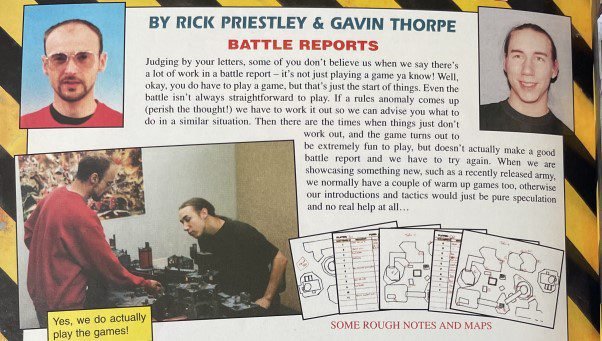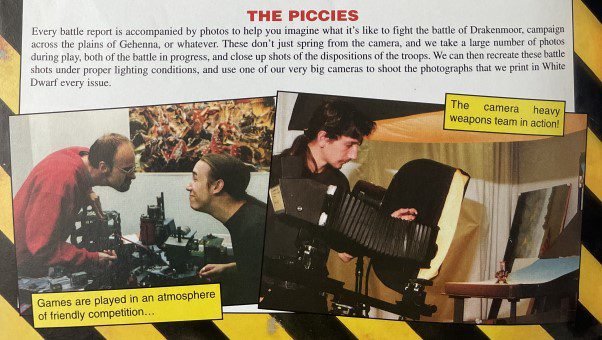As Bedroom Battlefields continues its mission to become a digital version of a 90s White Dwarf magazine, the latest legendary presence to give us some of their time (and wisdom) is Rick Priestley. (here are the conversations with Gav Thorpe, Andy Chambers, Tuomas Pirinen, and Alessio Cavatore!)
Rick Priestley is a name that resonates deeply within the world of tabletop gaming. With a career spanning several decades, Priestley has earned a reputation as a visionary game designer and a true luminary in the industry. He first rose to prominence in the early 1980s when he, alongside Bryan Ansell and Richard Halliwell, co-created the iconic Warhammer Fantasy Battle, a game that would forever change the course of tabletop gaming. His imagination knew no bounds, as evidenced by the grim and captivating universe he unveiled in Warhammer 40,000: Rogue Trader in 1987.

Post-GW, Priestley continued to shape the gaming landscape, lending his expertise through consulting work and involvement in Warlord Games, renowned for its historical miniature wargames. His influence extended to the design of the acclaimed World War II wargame Bolt Action in 2012, cementing his status as a game designer par excellence.
With an illustrious career marked by creativity, innovation, and a dedication to the art of gaming, Rick Priestley remains a beloved figure in the gaming community, leaving an enduring legacy that continues to inspire gamers and game designers alike.
It was a real privilege to be able to put some questions to Rick, and here’s what he had to say:
Why do you think this hobby still exists?
Rick Priestley: Wargaming – broadly – I can’t see any reason why it shouldn’t continue to exist, whether we are talking about tabletop, historical, board wargames, or video games. Historical tabletop wargames – my main interest – does seem to be an older crowd, but there’s plenty of younger players coming over from fantasy and science-fiction games.
Games Workshop has done a great job of bringing wargaming to the attention of youngsters; effectively recruiting new players and stimulating an interest in the model-driven tabletop wargame. The hobby as a whole has benefited from that, and I imagine will continue to do so for years to come.
Powered by RedCircle
What might people be surprised to hear you’re not very good at?
Rick Priestley: I’m not sure there are any surprises there! I’m pretty bad at exactly the sort of things you’d expect me to be bad at. Years ago, when folk used to ask me how to get into working in wargames, I used to have a stock answer: be bad a something else. At that time all the people I knew who worked in wargames had basically failed to do whatever it was they set out to do beforehand. My boss chucked in a degree in Maths to start a wargames company. Jervis Johnson gave up a career as an undertaker (it takes all sorts). And quite a few of us had worked in archaeology, including me. I wasn’t a very good archaeologist because I hated being outside in the pouring rain, shovelling spoil in the rain all day, sleeping in a wet tent, and resorting to the countryside by way of toilet facilities. All of these things had limited appeal.
After that, I tried my hand as a figure designer, but I couldn’t make enough to earn a decent living, and so got dragged into the world of casual work at Citadel doing mail order, and then a full-time job, and so on. Hence, my advice to anyone starting out in the world of wargames: be bad at something else, because if you’re good at something else, you’d be better off sticking to it!
When was the last time something in the hobby surprised you?
Rick Priestley: I think the development of thermoplastic resin injection into silicon rubber moulds was a bolt out of the blue. I never expected that technology to work. Oddly enough, many years ago, Games Workshop did have a go at developing rubber-in-steel inserts to fit into plastic injection moulding machines. That experiment never worked out. Basically, the pressure behind an injection moulding press is so great it distorts the rubber, no matter how stiff a rubber you use. This was in the days of ‘black’ organic rubber, so you had what you had, unlike today when you can get different grades of silicon rubber.
The company that pioneered that new technology has built its own injection machines of course, and to be honest it has not been plain sailing either. Teething problems aside, it’s now used commercially by several wargames manufacturers, and the quality of materials gets better all the time. That’s been a real game-changer.
Tell me something that’s true that almost nobody agrees with you on.
Rick Priestley: There is nothing so unbearably tedious as sport, especially football. Why people take an interest in this kind of thing, let alone raise individuals to the level of celebrity on the basis of kicking a ball, skipping, jumping about, etc, is all a mystery to me.
Tell me something you once believed about the hobby that turned out not to be true.
Rick Priestley: Nothing springs to mind, to be honest. When we did the third version of Warhammer, I thought we could extend the range to include not only army lists for competitive gaming but also narrative-based scenarios and campaigns. This being the sort of gaming I’d always enjoyed, I thought there’d be a market for campaign packs, and we produced a number, including The Grudge of Drong, Terror of the Lichemaster, and so on.
The idea was to expand the range of gaming, or rather to cater for a style of gaming that had hitherto been quite successful in earlier versions of Warhammer, e.g. Ork’s Drift. The trouble was, we’d been so successful with the new format of Army Books complete with army lists, that the game had turned towards that style of one-on-one competitive play. The new campaign packs did sell reasonably well, but sales expectations had moved forward, so they were not judged a success at the time and were dropped fairly shortly. So, I guess the market wasn’t what I hoped it was, and what people really wanted was army lists and competition-style games.
Are there any common hobby myths and misconceptions that make you roll your eyes?
Rick Priestley: Are there such things? I suppose there are a few odd things folks say about games I’ve written that continue to do the rounds even though they really aren’t true. One is that Warhammer was originally a free set of rules given away with mail order. That isn’t true, but it was an idea that was floated at the time, and we used to include stats and rules for Warhammer on mail-order sheets, so you can see how the story got around.
The other one is that some folks cite Laserburn as an early form of Warhammer 40,000 or influence upon it. It certainly wasn’t, but Bryan Ansell, who was running Games Workshop at the time, wrote Laserburn, and he would go on to initiate several projects for 40K supplements, so I suppose there may have been some ideas or concepts common to both. Oh – and Bolt Action is derived from 40K… it really, really, isn’t! Oddly enough, WH40K 3rd edition (and all subsequent editions that use that same basic mechanic) was derived from my home-crewed WW2 rules that John Stallard and I used to play 15mm WW2 games.

Tell me about a particularly satisfying mechanic you’ve either created yourself, or came across whilst playing someone else’s game (or both!)
Rick Priestley: I thought the turn over mechanic in Blood Bowl was an interesting way to sequence a game, and I took the idea and adapted it to my Warmaster system. So, to activate a unit you rolled dice to give an order; if successful you continued to move and order units, but if you failed, it’s turn over. It’s interesting because you have to decide which things to move first and which to leave until last and risk not being able to move at all. I later adapted the same mechanic to Black Powder and Hail Caesar for Warlord Games, so it’s had a good run!
Another mechanic that I’ve always thought would be interesting to adapt is the combat mechanism in a game called Warlord. Warlord is a game of nuclear warfare published in the 70s and later re-boxed and marketed by Games Workshop as Apocalypse. Anyway, it works like this:
When making an attack you take a dice and secretly select a number by hiding it behind your palm, you can only choose a number up to the total number of pieces you are attacking with. Your opponent guesses what number you have chosen, and if correct, you lose that number of pieces, if incorrect, your opponent loses one of their own pieces.
The attacker can stop at any point if things are not going well. Assuming things do go well, once an attacker removes the opponent’s last piece, you get to move into the space and take it over, but the number of pieces you move in has to be the number you last selected. Thus, the initial attacks can be random, although choosing a high value risks losing a high number of pieces, which encourages you to choose a low value… but your opponent knows this… and you know that they know… and so on.
When it comes to your last attack, the fact that you take the space with the number of pieces nominated means you want to choose as high a value as possible… but your opponent knows this… and you know that they know… and so on. I just like the element of double guessing and the potential for a lucky guess to unravel an attack.
Anything you’re working on right now that you’d like to share or promote with the audience?
Rick Priestley: I’ve hung up my spurs and can’t see me undertaking any big new projects anytime soon – retired now and enjoying gaming for its own sake 😊
Thank you so much for taking the time to speak to us, Rick!
Enjoyed this? Be sure to check out our chats with fellow industry heroes Gav Thorpe, Andy Chambers, Tuomas Pirinen, and Alessio Cavatore, too.
